This article brings you a detailed explanation of Lambda and Stream in Java8 (with code). It has certain reference value. Friends in need can refer to it. I hope it will be helpful to you.
1. Preface
This article mainly introduces the two main new features of Java8, lambda expression and Stream API. The two provide a higher level of abstraction and simplify development. ,Increase productivity.
2. Lambda expression
2.1 First introduction to Lambda expression
Create a thread and use an Runnableanonymous The internal class
Thread thread = new Thread(new Runnable() {
@Override
public void run() {
System.out.println("Hello Aron.");
}
});
may not seem like a big problem, but in fact the disadvantages are quite obvious: there are too many template syntaxes, and the only statements that really have business significance are System.out.println("Hello Aron."), because of this, also seriously interferes with our reading of the code.
After introducing lambda expression, you can write like this
Thread thread = new Thread(() -> System.out.println("Hello Aron."));
It’s too concise, is there any idea?
2.2 More Lambda expressions
Runnable runnable = () -> System.out.println("Hello World.");
Consumer<t> tConsumer = bean -> System.out.println("Hello World.");
Runnable runnable1 = () -> {
System.out.println("Hello World.");
System.out.println("Hello World.");
};</t>
The syntax is divided into 3 sections: parameters, -> and statements, that is, (...)- > { ...}
2.3 Function interface
Java is a strongly typed language, and method parameters have fixed types. So here’s the problem. Lambda expressions, if regarded as a bunch of code fragments, will also express a clear intention. This intention can be understood as a functional interface for the time being.
In the process of programming, you will always encounter many functional interfaces. The following are some of the most important functional interfaces in JDK
Examples of interface parameter return types
| Interface | Parameters | Return type | Example |
|---|---|---|---|
| boolean | Is the value equal to "Hello"? | ||
| T | void | Output a value | |
| T | R | Get a property of the object | |
| None | T | Factory Method | |
| T | T | Logical NOT (!) | |
| (T, T) | T | Find the sum of 2 numbers ( ) |
The above is the detailed content of Detailed explanation of Lambda and Stream in Java8 (with code). For more information, please follow other related articles on the PHP Chinese website!
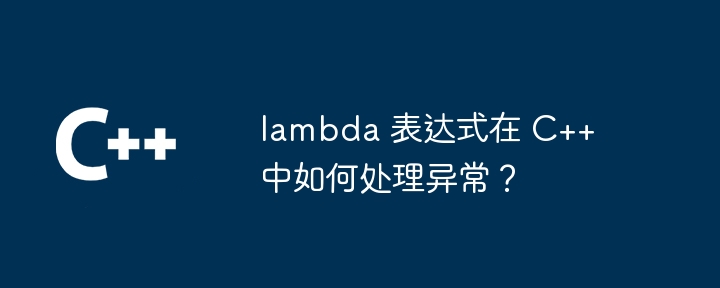 lambda 表达式在 C++ 中如何处理异常?Apr 17, 2024 pm 12:42 PM
lambda 表达式在 C++ 中如何处理异常?Apr 17, 2024 pm 12:42 PM在C++中,使用Lambda表达式处理异常有两种方法:使用try-catch块捕获异常,并在catch块中处理或重新抛出异常。使用std::function类型的包装函数,其try_emplace方法可以捕获Lambda表达式中的异常。
 Java 8中如何计算一年前或一年后的日期?Apr 26, 2023 am 09:22 AM
Java 8中如何计算一年前或一年后的日期?Apr 26, 2023 am 09:22 AMJava8计算一年前或一年后的日期利用minus()方法计算一年前的日期packagecom.shxt.demo02;importjava.time.LocalDate;importjava.time.temporal.ChronoUnit;publicclassDemo09{publicstaticvoidmain(String[]args){LocalDatetoday=LocalDate.now();LocalDatepreviousYear=today.minus(1,ChronoUni
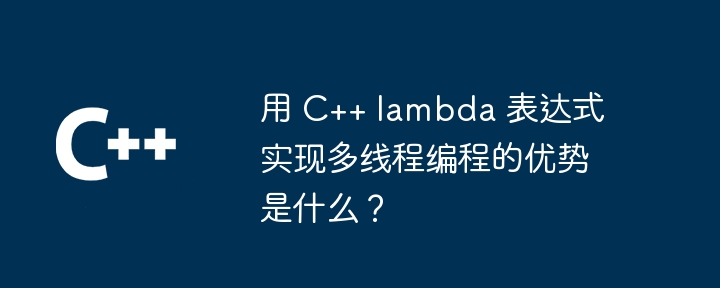 用 C++ lambda 表达式实现多线程编程的优势是什么?Apr 17, 2024 pm 05:24 PM
用 C++ lambda 表达式实现多线程编程的优势是什么?Apr 17, 2024 pm 05:24 PMlambda表达式在C++多线程编程中的优势包括:简洁性、灵活性、易于传参和并行性。实战案例:使用lambda表达式创建多线程,在不同线程中打印线程ID,展示了该方法的简洁和易用性。
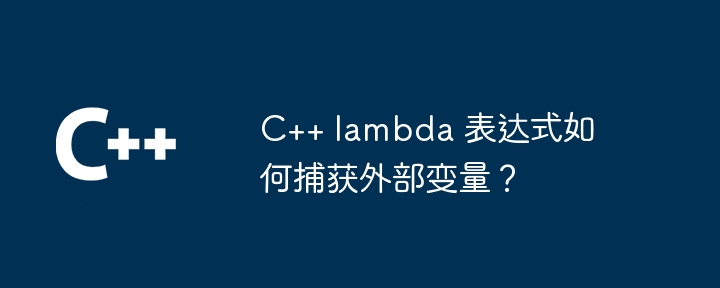 C++ lambda 表达式如何捕获外部变量?Apr 17, 2024 pm 04:39 PM
C++ lambda 表达式如何捕获外部变量?Apr 17, 2024 pm 04:39 PM在C++中捕获外部变量的lambda表达式有三种方法:按值捕获:创建一个变量副本。按引用捕获:获得变量引用。同时按值和引用捕获:允许捕获多个变量,按值或按引用。
 如何使用Java 8计算一周后的日期?Apr 21, 2023 pm 11:01 PM
如何使用Java 8计算一周后的日期?Apr 21, 2023 pm 11:01 PMJava8如何计算一周后的日期这个例子会计算一周后的日期。LocalDate日期不包含时间信息,它的plus()方法用来增加天、周、月,ChronoUnit类声明了这些时间单位。由于LocalDate也是不变类型,返回后一定要用变量赋值。packagecom.shxt.demo02;importjava.time.LocalDate;importjava.time.temporal.ChronoUnit;publicclassDemo08{publicstaticvoidmain(String[
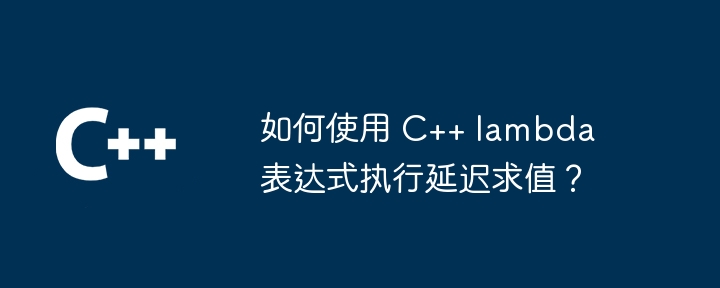 如何使用 C++ lambda 表达式执行延迟求值?Apr 17, 2024 pm 12:36 PM
如何使用 C++ lambda 表达式执行延迟求值?Apr 17, 2024 pm 12:36 PM如何使用C++lambda表达式执行延迟求值?使用lambda表达式创建延迟求值的函数对象。延迟计算推迟到需要时才执行。仅当需要时才计算结果,提高性能。
 使用 C++ lambda 表达式有哪些注意事项?Apr 17, 2024 pm 12:15 PM
使用 C++ lambda 表达式有哪些注意事项?Apr 17, 2024 pm 12:15 PM使用C++lambda表达式时需注意:小心捕获变量,避免意外修改。可通过引用或值捕获变量,引用捕获用于修改外部变量。lambda表达式生命周期与捕获它的函数不同,可能导致内存泄漏。考虑使用函数指针或函数对象以优化性能。
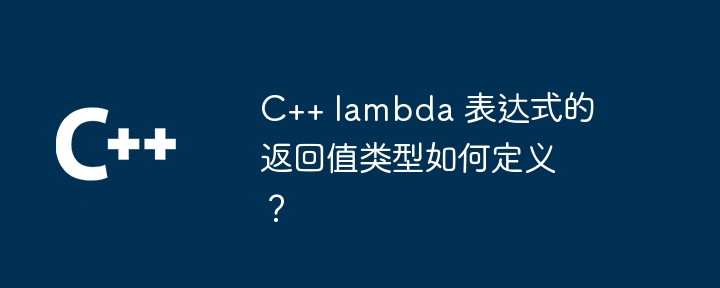 C++ lambda 表达式的返回值类型如何定义?Apr 17, 2024 pm 04:15 PM
C++ lambda 表达式的返回值类型如何定义?Apr 17, 2024 pm 04:15 PM在C++中,Lambda表达式的返回值类型通过->return-type指定,允许明确定义lambda的返回值。通过指定返回值类型,可以增强代码的可读性并避免编译器自动推断类型带来的潜在错误。


Hot AI Tools

Undresser.AI Undress
AI-powered app for creating realistic nude photos

AI Clothes Remover
Online AI tool for removing clothes from photos.

Undress AI Tool
Undress images for free

Clothoff.io
AI clothes remover

AI Hentai Generator
Generate AI Hentai for free.

Hot Article

Hot Tools

EditPlus Chinese cracked version
Small size, syntax highlighting, does not support code prompt function

ZendStudio 13.5.1 Mac
Powerful PHP integrated development environment

Safe Exam Browser
Safe Exam Browser is a secure browser environment for taking online exams securely. This software turns any computer into a secure workstation. It controls access to any utility and prevents students from using unauthorized resources.

Dreamweaver Mac version
Visual web development tools

VSCode Windows 64-bit Download
A free and powerful IDE editor launched by Microsoft







